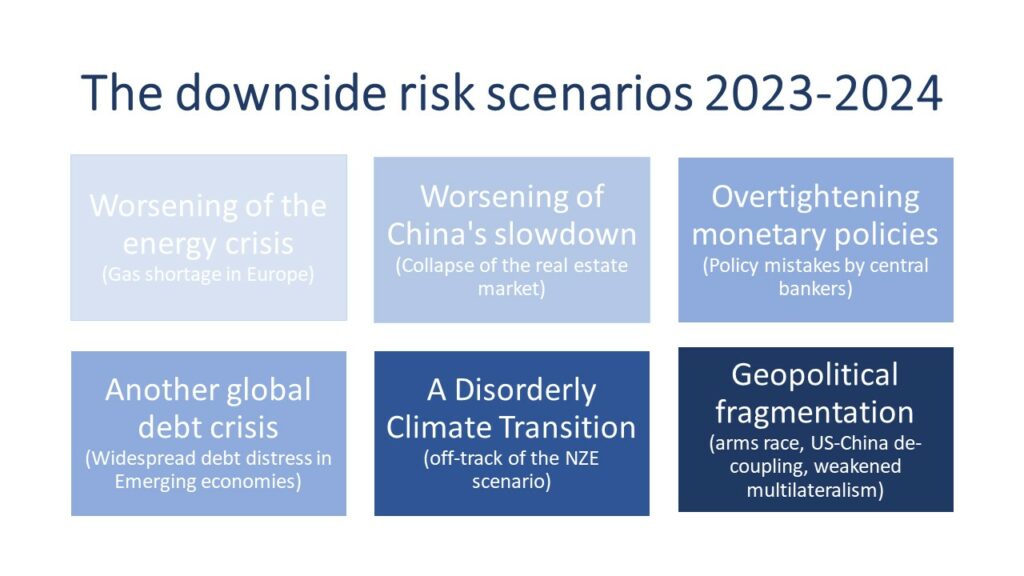The traditional batch of annual economic outlook reports released end of 2022 and in January this year – including the IMF (October & January update ), OECD (November), World Bank (January), the European Commission (November), the European Central Bank (December) & US Federal Reserve (November) – all come with the same message: at best the current global economy slowdown will stabilise in 2023, at worst, it will transform into recessions: in Europe probably, in the US possibly, in energy dependent and/or debt loaded emerging economies if things really turn bad.
Global growth projections for 2023 have been continuously downgraded since the last round of reports in April-June 2022. Latest GDP growth forecasts for 2023 range from +1.7 % for the World Bank to +2.6% for the IMF (as of end January). In any event, we are set for the lowest growth rate of the last 20 years, except for 2009 (global financial crisis) and 2020 (Covid-19 lock-downs). A rebound is now pushed back to the second half of 2024.
These forecasts contrast with the very same reports released mid-2022 and which foresaw a soft landing in 2023 and, early 2024, a return to business as usual and the Great Moderation – low inflation, low interest rates, cheap debt. In the meantime, some of the key assumptions of the mid-2022 reports did not materialise to say the least:
- Central banks were expected to successfully engage an “orderly tightening” of monetary policy to curb inflationary pressures. That did not happen. Inflation is still there, and tightening is continuing;
- The war in Ukraine would be contained and no further sanctions, no further disruptions to energy supply arise. The war may be “contained” but escalation is happening and there are definitely disruptions in energy supply in Europe;
- The bottlenecks in labour markets and in global supply chains would gradually resolve. The supply side constraints are persistent and cannot be put on the back of a temporary post-covid re-opening boost, while job vacancies are at all-time high;
Inflation is and will remain well above central banks’ targets in virtually all countries that have adopted inflation targeting. Persistent core inflation suggests that the causes are structural and linked to supply side constraints, rather than demand-side overheating. If so, inflation will not be easily dealt with through central banks’ policy interest rates. Contrary to the 1970ies and the much feared “wage-price spiral” scenario (wage growth negotiations exceeding, and hence feeding inflation), wage increases in 2022 did not keep up with price inflation despite labour shortages and the record number of vacancies. Real wages and household disposable incomes have been declining in most OECD economies.
The downside scenarios
The above mentioned reports by the IMF, OECD, the World Bank, EC, ECB and US Federal Reserve all have downside risk scenarios for 2023 and 2024. Taking on board the findings of other leading forums, including the World Economic Forum and the Atlantic Council , as well as a selection of global financial businesses (including Allianz, BlackRock, BNP Paribas, Citi, Deutsche Bank, Goldman Sachs, ING & Natixis ), we have the following list:

The worsening of the energy crisis is seen as the top risk scenario by almost all of the international organisations (most notably the EC, ECB, IMF and OECD). Russia completely halts gas supplies to Europe and the search for alternative sources of supply fails to compensate. Europe would inevitably fall into recession. The United States would be on the edge of it.
The worsening of China’s slowdown. Shifting to a middle class consumption growth model has been a long standing objective of the Chinese authorities, but progress has been slow. The building and the property sector has been the real engine of growth in China in recent years accounting for roughly 25% of GDP. As growth is very unlikely to be pulled by exports – given the depressed economic situation in Europe and the US – the Chinese economy hinges on the stability of property sector. A real estate market crisis in China, amplified by the high levels of corporate debt, would reverberate globally.
Overtightening monetary policies. Central bankers making a “policy mistake” is a widely shared concern among international organisations and financial institutions. “The risk of policy missteps is elevated” (World Bank), it could happen if “underlying inflation does come down, but central banks are late in recognizing the improvement” (Goldman Sachs). Europe and the United States would be on the edge of recession. For Keynesian economists – a rare commodity lately – not only would further tightening be a mistake, but the very use of interest rate hikes to curb supply-side inflation is entirely ineffective.
Another global debt crisis. The on-going monetary tightening could set off a chain reaction worldwide, a central concern for the World Bank and the IMF. The scale of sovereign debt defaults could significantly rise in emerging markets. According to the IMF analyses of 69 low-income countries, 9 countries are already in debt distress, 28 at high risk, and 25 at moderate risk. With unsustainable import bills, limited fiscal space, and closed access to short-term funding from international markets, the economic and social consequences could replicate Sri Lanka’s recent crisis. Europe and the US would be severally impacted with a high probability of recession.
A disorderly climate transition. In addition to more extreme weather events, 2023 could see the gap increase further between reality and ambition of the Paris Agreement. Several factors would be at play:
- Impact of the debt crisis: countries are unable to mobilise funding for clean energy, which estimates are based on cheap debt assumptions.
- The “inflation argument” against climate creeps in policymakers’ circles: clean energy becomes wrongly so, associated with inflation and supply constraints. For Black Rock, “the transition [to net-zero] is set to add to production constraints, leading to more volatile inflation”.
- A zero-sum game between adaption and mitigation: a surge in climate adaptation, loss and damage leads to “backsliding on mitigating climate change”.
- Failed Just Transition: the social cost transition is uncontrolled, together with the rise of the populists and the far right, it turns large parts of middle class and working class against climate transition.
- Loss of momentum among businesses and investors: ineffective responsible investment practices (“greenwashing”), resistance or passivity of shareholders, absence of level playing field mechanisms by governments.
Geopolitical risks feature unusually high in the economic outlooks. The challenge of course is for economists to predict and “quantify” the economic consequences of armed conflicts and geopolitical tensions. Three broad risk scenarios emerge:
- Geopolitical insecurity scaling up. The list of geopolitical risks is long, the most cited ones include: (i) a deadlock in Ukraine or a Russian victory, (ii) a just short of war conflict over Taiwan, and (iii) another Middle East crisis. Global insecurity would among other lead to a new arms race and redoubling of defence spendings in Europe in particular, with tough fiscal trade-offs to make.
- “Geoeconomic warfare” and “weaponizing” economic and trade policies to proactively constrain “rival nations” are already happening but could reach new levels and to a G2 polarised world, rising protectionism and redrawing global supply along two blocks: US & China.
- Finally, weakened multilateralism would manifest in the paralysis of key forums, including the upcoming COP meeting, WHO, UN, WTO, G20, which in turn would amplify the economic and social consequences of the economic downturn and any of above downside risk scenarios.
